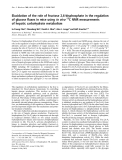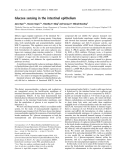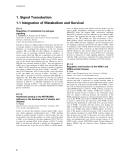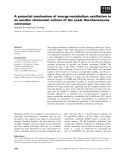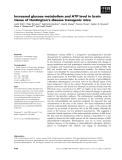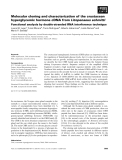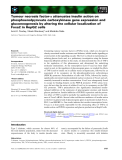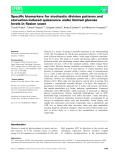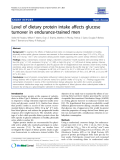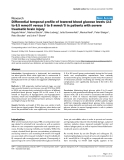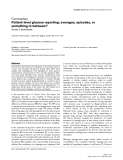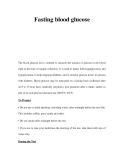
Glucose levels
-
Insulin is the principal regulatory hormone involved in the tight regulation of fuel metabolism. In response to blood glucose levels, it is secreted by the b cells of the pancreas and exerts its effects by binding to cell surface receptors that are present on virtually all cell types and tissues. In humans, perturbations in insulin function and/or secretion lead to diabetes mellitus, a severe disorder primarily characterized by an inability to maintain blood glucose homeostasis. Furthermore, it is estimated that 90–95% of diabetic patients exhibit resistance to insulin action....
 10p
10p  research12
research12
 01-06-2013
01-06-2013
 35
35
 4
4
 Download
Download
-
Fructose 2,6-bisphosphate (Fru-2,6-P2 ) plays an important role in the regulation of major carbohydrate fluxes as both allosteric activator and inhibitor of target enzymes. To examine the role of Fru-2,6-P2in the regulation of hepatic carbohydrate metabolism in vivo,Fru-2,6-P2 levels were elevated in ADM mice with adenovirus-mediated overex-pression of a double mutant bifunctional enzyme, 6-phos-phofructo-2-kinase/fructose-2,6-bisphosphatase (n¼6), in comparison to normal control mice (control,n¼6). ...
 9p
9p  research12
research12
 29-04-2013
29-04-2013
 50
50
 5
5
 Download
Download
-
Dietary sugars regulate expression of the intestinal Na + / glucose cotransporter, SGLT1, inmany species.Using sheep intestine as a model, we showed that lumenal monosaccha-rides, both metabolisable and nonmetabolisable, regulate SGLT1 expression. This regulation occurs not only at the level of transcription, but also at the post-transcriptional level. Introduction of D-glucose andsome D-glucose ana-logues into ruminant sheep intestine resultedin 50-fold enhancement of SGLT1 expression.
 12p
12p  tumor12
tumor12
 20-04-2013
20-04-2013
 34
34
 2
2
 Download
Download
-
WhenSaccharomyces cerevisiaecells, grown in galactose, glucose or mannose, were treated with 1.5 mMhydrogen peroxide (H2O2) for 30 min, an important decrease in the ATP, and a less extensive decrease in the GTP, CTP, UTP and ADP-ribose levels was estimated. Concomitantly a net increase in the inosine levels was observed. Treatment with 83mMmenadionepromoted theappearanceof acompound similar to adenosine but no appreciable changes in the nucleotide content of yeast cells, grown either in glucose or galactose....
 12p
12p  tumor12
tumor12
 20-04-2013
20-04-2013
 42
42
 3
3
 Download
Download
-
Estrogen is known to influence glucose homeostasis but the role of estrogen receptors in muscle glucose metabolism is unknown. Therefore, we investigated the expression of the two estrogen receptors, ERa and ERb and their influence on regulation of GLUT4, and its associated structural protein, caveolin-1, in mouse muscle. ERaand ERbare co-expressed in the nuclei of most muscle cells and their levels were not affected by absence of estradiol (in aromatase knockout, ArKO, mice).
 6p
6p  inspiron33
inspiron33
 26-03-2013
26-03-2013
 46
46
 4
4
 Download
Download
-
The energy-metabolism oscillation in aerobic chemostat cultures of yeast is a periodic change of the respiro-fermentative and respiratory phase. In the respiro-fermentative phase, the NADH level was kept high and respiration was suppressed, and glucose was anabolized into trehalose and glycogen at a rate comparable to that of catabolism.
 14p
14p  inspiron33
inspiron33
 26-03-2013
26-03-2013
 56
56
 4
4
 Download
Download
-
The bifunctional enzyme glucose-6-phosphate dehydrogenase-6-phospho-gluconolactonase (G6PD-6PGL) found in Plasmodium falciparum has unique structural and functional characteristics restricted to this genus. This study was designed to examine the effects of RNA-mediated PfG6PD-6PGL gene silencing in cultures ofP. falciparumon the expression of para-site antioxidant defense genes at the transcription level.
 10p
10p  inspiron33
inspiron33
 26-03-2013
26-03-2013
 48
48
 5
5
 Download
Download
-
Huntington’s disease (HD) is a progressive neurodegenerative disorder characterized by multifarious dysfunctional alterations including mitochon-drial impairment. In the present study, the formation of inclusions caused by the mutation of huntingtin protein and its relationship with changes in energy metabolism and with pathological alterations were investigated both in transgenic and 3-nitropropionic acid-treated mouse models for HD.
 16p
16p  inspiron33
inspiron33
 23-03-2013
23-03-2013
 38
38
 6
6
 Download
Download
-
The crustacean hyperglycemic hormone (CHH) plays an important role in the regulation of hemolymph glucose levels, but it is also involved in other functions such as growth, molting and reproduction. In the present study we describe the first CHH family gene isolated from the Atlantic Ocean shrimp Litopenaeus schmitti.
 9p
9p  inspiron33
inspiron33
 23-03-2013
23-03-2013
 43
43
 4
4
 Download
Download
-
Circulating tumour necrosis factor-a(TNFa) levels, which are elevated in obesity-associated insulin resistance and diabetes, inhibit insulin signalling at several points in the signalling cascade. The liver is critical in maintaining cir-culating glucose levels and, in a preliminary investigation using the human hepatoma (HepG2) cell line in this study, we demonstrated the role of TNFa in the regulation of this phenomenon and determined the underlying molecular mechanisms.
 13p
13p  vinaphone15
vinaphone15
 25-02-2013
25-02-2013
 43
43
 2
2
 Download
Download
-
Glucose as a source of energy is centrally important to our understanding of life. We investigated the cell division–quiescence behavior of the fission yeastSchizosaccharomyces pombeunder a wide range of glucose concentra-tions (0–111 mM). The mode of S.
 0p
0p  cosis54
cosis54
 05-01-2013
05-01-2013
 40
40
 2
2
 Download
Download
-
Tuyển tập báo cáo các nghiên cứu khoa học quốc tế ngành y học dành cho các bạn tham khảo đề tài: Level of dietary protein intake affects glucose turnover in endurance-trained men
 4p
4p  dauphong1
dauphong1
 22-12-2011
22-12-2011
 30
30
 3
3
 Download
Download
-
Tuyển tập các báo cáo nghiên cứu về y học được đăng trên tạp chí y học Critical Care giúp cho các bạn có thêm kiến thức về ngành y học đề tài: Differential temporal profile of lowered blood glucose levels (3.5 to 6.5 mmol/l versus 5 to 8 mmol/l) in patients with severe traumatic brain injury...
 13p
13p  coxanh_4
coxanh_4
 27-10-2011
27-10-2011
 55
55
 4
4
 Download
Download
-
Tuyển tập các báo cáo nghiên cứu về y học được đăng trên tạp chí y học Critical Care giúp cho các bạn có thêm kiến thức về ngành y học đề tài: Formulas Patient-level glucose reporting: averages, episodes, or something in between?
 2p
2p  coxanh_4
coxanh_4
 26-10-2011
26-10-2011
 33
33
 3
3
 Download
Download
-
The blood glucose test is ordered to measure the amount of glucose in the blood right at the time of sample collection. It is used to detect both hyperglycemia and hypoglycemia, to help diagnose diabetes, and to monitor glucose levels in persons with diabetes. Blood glucose may be measured on a fasting basis (collected after an 8 to 10 hour fast), randomly (anytime), post prandial (after a meal), and/or as part of an oral glucose tolerance test (OGTT / GTT). To Prepare • Do not eat or drink anything, including water, after midnight before the test (6h). This includes...
 3p
3p  truongthiuyen1
truongthiuyen1
 08-06-2011
08-06-2011
 62
62
 4
4
 Download
Download
CHỦ ĐỀ BẠN MUỐN TÌM










